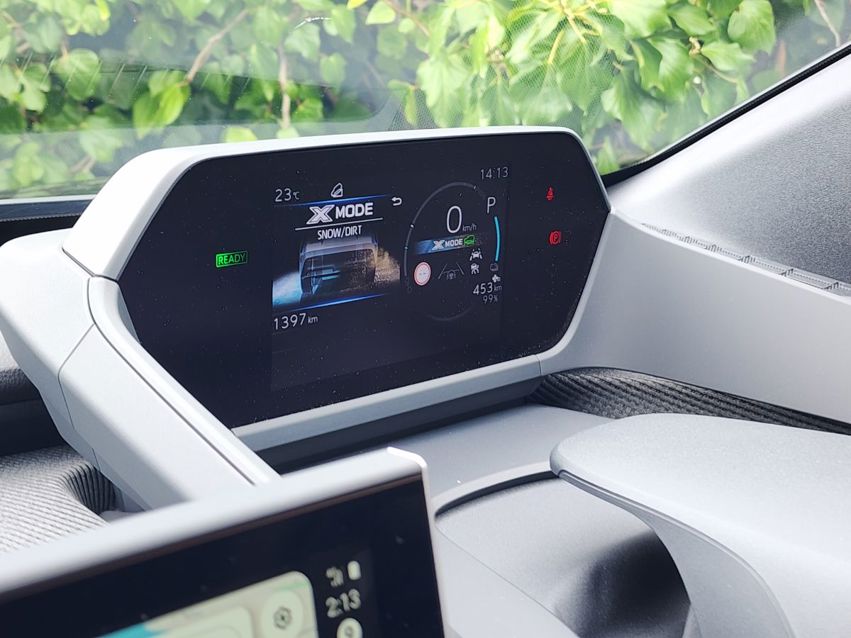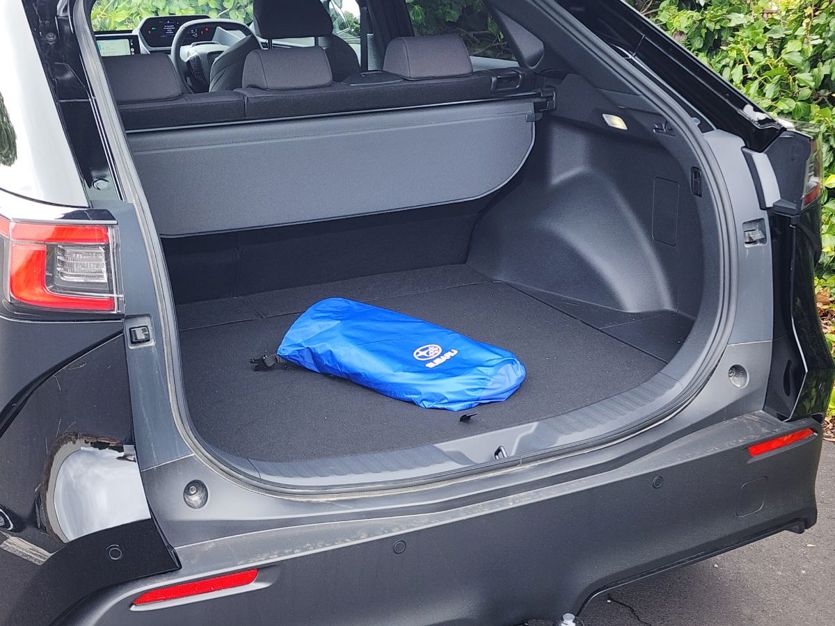As we all know, the Subaru Solterra EV is the product of a co-development with Toyota (bZ4X). It’s fair to say that Toyota was the lead partner, but don’t assume that means all Subaru has done is create a new grille shape and stick some badges on.

You don’t have to take Subaru’s word for that. You don’t even have to take our word for that. Instead, take the word of Toyota bZ4X chief engineer Masaya Uchiyama, who visited New Zealand this month.
“This was truly a joint development,” says Uchiyama-san. “Hundreds of Subaru engineers came to Toyota. The focus points were different [and] we had many conflicts with Subaru, but because of the conflict we could see the vehicle from many different aspects. I believe that made this vehicle better.”
Uchiyama-san makes special mention of the electric AWD system, which “combines the knowhow” of both companies and incorporates Subaru’s X-Mode, with settings for snow, dirt and mud, with Grip Control.
“It’s a real breakthrough.”

The basic design, powertrain features and back-end software used by Solterra and bZ4X are virtually identical. Visually, the Subaru has unique frontal styling and although it might not seem obvious, the tailgate pressings are also different for each; although they look so very similar, you have to wonder why.
What’s the biggest difference between the two really? It’s the suspension.
Another point of difference is the solid light bar across the back of the Toyota, versus the illumination of the Subaru that fades out as each side goes towards the centre (so it’s not a bar as such).

What’s the biggest difference between the two really? According to Uchiyama-san, it’s the suspension: “We wanted to make bZ4X a Toyota car, Subaru wanted to make Solterra a Subaru car. The Toyota has a softer suspension, the Subaru a more solid suspension.”
The Solterra has two powertrain-control features the bZ4X lacks: a pushbutton Power mode and adjustable-regen.
We’ve now spent some time in the production version of the bZ4X after two months in an early build car, and a week in the Solterra. The two were with us on the very same week, in fact.

And we have to say it’s pretty hard to separate the two. Which is not a bad thing, because they are a brace of really impressive mainstream EVs. We love the ease of use, the quirky-looking cabin that’s actually very sound in terms of ergonomics (that square steering wheel is a Subaru exclusive) and a pretty decent range given a smaller battery than most rivals: 71.4kWh.
You could make a strong argument that this entry Solterra is the sweet spot for keen drivers.
Which brings us to the really big question: what’s the case for the subject of this review, the entry-level $79,990 Solterra, over any other model in this Subaru-Toyota EV lineup?

Well, it might be that you’re just a Subaru person and that’s cool. It might be that you want the least expensive way into AWD, given the entry $72,990 bZ4X Pure is FWD only and the bZ4X Motion AWD is $82,990.
Or it might be that you want the version that has those extra little touches that make it a bit more driver-focused. In terms of suspension, we honestly don’t feel there’s a whole lot in it on Kiwi roads, but after hearing Uchiyama-san’s comments we did a bit of back-and-forth between bZ4X and Solterra, both on identical 18-inch wheels. And yes, the Solterra is a bit firmer and more controlled, the bZ4X more comfort-oriented.

In addition, the Solterra has two powertrain-control features the bZ4X lacks: a pushbutton Power mode, which doesn’t actually liberate more power but does make the maximum available more readily, and sharpens the throttle response. Solterra has a more aggressive one-pedal drive setting than bZ4X anyway, but the Subaru adds steering wheel paddles to switch between different levels.
While neither brand would probably admit it, there is actually a logical flow between bZ4X and Solterra as you go up their respective ranges.

The bZ4X Pure is still lavishly equipped while being the only FWD version available, but it’s also easy to see the extra $7k in the Solterra: you get the dual-motor AWD (although only another 10kW in total) with X-Mode, those extra control features and a few detail touches like power sunroof and 360-degree camera (the Toyota only gets a reversing display). Although the Subaru lacks the wireless phone charging of the Toyota, which is an oversight when there’s a good wireless projection system as standard (which does tend to eat up your battery).
From there it’s up to the bZ4X Motion AWD at $82,990, with the Solterra Touring top of the tree at $84,990.

You could indeed make an argument that this entry Solterra is the sweet spot for keen drivers. You get the firmer Subaru suspension for better body control, but combined with the smallest 18-inch wheel-and-tyre combination from the bZ4X Pure (same aero plastic wheel covers, too), which takes the edge off the ride. The top Subaru and Toyota AWD versions both have 20-inch wheels.
BATTERY: 71.4kWh battery with dual electric motors POWER: 160kW/168Nm GEARBOX: Single-speed automatic, AWD RANGE: 465km (WLTP) PRICE: $79,990
How much is the Subaru Solterra?
At $79,990 the entry Solterra was priced to stay under the $80k cap for the now-defunct Clean Car Discount. But the sticker hasn't moved since.
What are the key statistics for the Subaru Solterra powertrain?
Same 71.4kWh battery as the sister Toyota bZ4X and same dual-motor setup as the AWD Toyota version. But Subaru differs in making AWD standard (the entry bZ4X is FWD).
Is the Subaru Solterra efficient?
The battery is smaller than the class average, but the range is good at well over 400km in our day-to-day driving with the car.
Is the Subaru Solterra good to drive?
Slightly sportier than the sister Toyota, but not at the expense of a decent ride at speed. The Subaru also has some extra driver-centric features, like configurable-regen and a Power mode. The electric AWD system is very impressive of low-friction surfaces and/or off-tarmac situations.
Is the Subaru Solterra practical?
It's slightly longer than a Forester, much longer in the wheelbase, and compares really well in terms of cabin space, although it's not as tall and the boot is a bit smaller. That's opportunity cost for a sleeker look.
What do we like about the Subaru Solterra?
It's a good drive while being truly accessible as day-to-day transports, there's a good mix of high-tech and ease-of-use with physical switchgear, it's a bit more driver-centric than the Toyota equivalent.
What don’t we like about the Subaru Solterra?
It looks more conservative than the Toyota to our eyes (that might be a plus for some), smaller battery than class average, wireless phone projection (which it has) demands wireless phone charging (which this entry version does not have).
What kind of person would the Subaru Solterra suit?
Somebody who wants a good-to-drive EV with day-to-day ease of use, somebody who want the assurance of a really good electric AWD system, or maybe just a "Subaru person": if you didn't know about the Toyota connection, you'd still think this was an EV with genuine Subaru values.
















